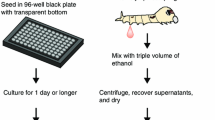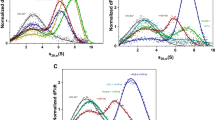Abstract
Ecdysteroids initiate molting and metamorphosis in insects via a receptor which belongs to the superfamily of nuclear receptors. The ecdysone receptor consists of two proteins: the ecdysone receptor (EcR) and the ultraspiracle (Usp). The EcR–Usp dimer conducts transcription through a hsp27 pal response element. Usp acts as an anchor orienting the whole complex on the DNA. The molecular beacon methodology was applied to detect the sequence-specific DNA of a natural hsp27 pal or mutated protein interaction with the DNA binding domain from the Usp. The dissociation constant, K d, of the UspDBD–hsp27 pal complex was determined to be 1.42 ± 0.48 nM, whereas K d for UspDBDΔA–hsp27 pal was 6.6 ± 0.5 nM. Mutation of Val-71 for Ala blocks formation of the protein-DNA complex in contrast to Glu-19 mutation for Ala for which K d = 4.31 ± 1.01 nM. The results obtained with the molecular beacon technology are related to those obtained by fluorescence anisotropy titrations.




Similar content being viewed by others
Abbreviations
- DBD:
-
DNA binding domain
- 20E:
-
20-hydroxyecdysone
- hsp27 pal :
-
20-hydroxyecdysone response element consisting of an imperfect palindrome from the promoter region of the Drosophila hsp27 gene
- RXR:
-
retinoid X receptor
- Usp:
-
product of the ultraspiracle gene
- UspDBD:
-
Usp DNA binding domain
- EcR:
-
product of the EcR gene
- FRET:
-
fluorescence resonance energy transfer
- EMSA:
-
electrophoretic mobility shift assay
References
Oro AE, McKeown M, Evans RM (1990) Relationship between the product of the Drosophila ultraspiracle locus and the vertebrate retinoid X receptor. Nature 347(6290):298–301
Devarakonda S, Harp JM, Kim Y, Ożyhar A, Rastinejad F (2003) Structure of the heterodimeric ecdysone receptor DNA-binding complex. EMBO J 22:5827–5840
Jakób M, Kołodziejczyk R, Orłowski M, Krzywda S, Kowalska A, Dutko-Gwóźdź J, Gwóźdź T, Kochman M, Jaskólski M, Ożyhar A (2007) Novel DNA-binding element within the C-terminal extension of the nuclear receptor DNA-binding domain. Nucleic Acid Res 35:2705–2718
Heyduk T, Heyduk E (2002) Molecular beacons for detecting DNA binding proteins. Nat Biotechnol 20:171–176
Culha M, Stokes DL, Griffin GD, Vo-Dinh T (2004) Application of a miniature biochip using the molecular beacon probe in breast cancer gene BRCA1 detection. Biosens Bioelectron 19(9):1007–1012
Riddihough G, Pelham HRB (1987) An ecdysone response element in the Drosophila hsp27 promoter. EMBO J 6:3729–3734
Martinez E, Givel F, Wahli W (1991) A common ancestor DNA motif for invertebrate and vertebrate hormone response elements. EMBO J 1(10):263–268
Ożyhar A, Kiltz HH, Pongs O, (1991) Characterization of a specific ecdysteroid receptor-DNA complex reveals common properties for invertebrate and vertebrate hormone-receptor/DNA interactions. Eur J Biochem 200(2):329–335
Hall BL, Thummel CS (1998) The RXR homolog ultraspiracle is an essential component of the Drosophila ecdysone receptor. Development 125(23):4709–4717
Lakowicz JR (1999) In principles of fluorescence spectroscopy, 2nd Ednnd edn. Kluwer, New York
LeTilly V, Royer CA (1993) Fluorescence anisotropy assays implicate protein–protein interactions in regulating trp repressor DNA binding. Biochemistry 3; 32(30):7753–7758
Lundbäck T, Zilliacus J, Gustafsson J-Å, Carlstedt-Duke J, Härd T (1994) Thermodynamics of sequence-specific glucocorticoid receptor–DNA interactions. Biochemistry 33:5955–5965
Boyer M, Poujol N, Margeat E, Royer CA (2000) Quantitative characterization of the interaction between purified human estrogen receptor α and using fluorescence anisotropy. Nucleic Acids Res 28:2494–2502
Zhao Q, Chasse SA, Sierk SD, Ahvazi B, Rastinjad F (2000) Structural basis of RXR–DNA interactions. J Mol Biol 296:509–520
Heyduk E, Knoll E, Heyduk T (2003) Molecular beacons for detecting DNA binding proteins: mechanism of action. Anal Biochem 316:1–10
Szatkowski-Ozers M, Hill JJ, Ervin K, Wood JR, Nardulli A, Royer CA, Gorski J (1997) Equilibrium binding of estrogen receptor with DNA using fluorescence anisotropy. J Biol Chem 272:30405–30411
Niedziela-Majka A, Kochman M, Ożyhar A (2000) Polarity of the ecdysone receptor complex interaction with the palindromic response element from the hsp27 gene promoter. Eur J Biochem 267:507–519
Grad I, Niedziela-Majka A, Kochman M, Ożyhar A (2001) Analysis of Usp DNA binding domain targeting reveals critical determinants of the ecdysone receptor complex interaction with the response element. Eur J Biochem 268:1–9
Gill SC, von Hippel PH (1989) Calculation of protein extinction coefficients from amino acid sequence data. Anal Biochem 182:319–326 (With erratum in: (1990) Anal Biochem. 189: 283)
Wilson TE, Paulsen RE, Padgett KA, Milbrandt J (1992) Participation of non-zinc finger residues in DNA binding by two nuclear orphan receptors. Science 256:107–110
Kowalska A, Rymarczyk G, Grad I, Orłowski M, Krowarsch D, Ożyhar A (2003) Residues of the C-terminal region (T-box) of the Ultraspiracle nuclear receptor DNA-binding domain crucial to specific interaction with the hsp27 response element. Acta Bioch Pol 50:99(Special issue: Abstracts of the 39th meeting of the Polish Biochemical Society)
Orłowski M, Szyszka M, Kowalska A, Grad I, Zoglowek A, Rymarczyk G, Dobryszycki P, Krowarsch D, Rastinejad F, Kochman M, Ozyhar A (2004) Plasticity of the ecdysone receptor DNA binding domain. Mol Endocrinol 18(9):2166–2184
Gronemeyer H, Laudet V (1995) Nuclear receptors: Sequences of nuclear receptors in Protein Profile. In: Sheterline P (ed) vol 2, pp 1184–1192, Academic Press, London
Kersten S, Gronemeyer H, Noy N (1997) The DNA binding pattern of the retinoid X receptor is regulated by ligand-dependent modulation of its oligomeric state. J Biol Chem 272:12771–12777
Schwabe JWR, Chapman L, Finch JT, Rhodes D (1993) The crystal structure of the oestrogen receptor DNA-binding domain bound to DNA: how receptors discriminate between their response elements. Cell 75:567–578
Rastinejad F, Perlmann T, Evans RM, Sigler PB (1995) Structural determinants of nuclear receptor assembly on DNA direct repeats. Nature 375:203–211
Zhao Q, Khorasanizadeh S, Miyoshi Y, Lazar MA, Rastinejad F (1998) Structural elements of an orphan nuclear receptor–DNA complex. Mol Cell 1(6):849–861
Meinke G, Sigle PB (1999) DNA-binding mechanism of the monomeric orphan nuclear receptor NGFI-B. Nature Struc Biol 6:471–477
Rastinejad F, Wagner T, Zhao Q, Khorasanizadeh S (2000) Structure of the RXR-RAR DNA-binding complex on the retinoic acid response element DR1. EMBO J 19:1045–1054
Knoll E, Heyduk T (2004) Unimolecular beacons for the detection of DNA-binding proteins. Anal. Chem. 76(4):1156–1164
Acknowledgments
This work was supported by a grant from the Polish Ministry of Science and Higher Education 3552/P01/2006/31. We thank Wroclaw University of Technology for partial support. We thank Dr. A. Kowalska for the gift of UspDBDV71A protein.
Author information
Authors and Affiliations
Corresponding author
Rights and permissions
About this article
Cite this article
Krusiński, T., Wietrzych, M., Grad, I. et al. Equilibrium Analysis of the DNA Binding Domain of the Ultraspiracle Protein Interaction with the Response Element from the hsp27 Gene Promoter—the Application of Molecular Beacon Technology. J Fluoresc 18, 1–10 (2008). https://doi.org/10.1007/s10895-007-0285-y
Received:
Accepted:
Published:
Issue Date:
DOI: https://doi.org/10.1007/s10895-007-0285-y




